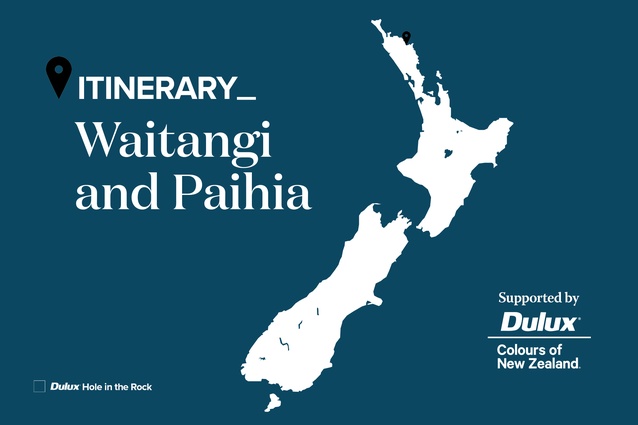Itinerary: Waitangi and Paihia
In this month's itinerary, supported by Dulux Colours of New Zealand, Andrew Barrie and Miro Sumich highlight thirteen historic sites across Waitangi and Paihia.
Te Pēwhairangi Bay of Islands has a rich history of occupation, extending back to the first arrival and including important wāhi tapu relating to key Ngapuhi ancestors located on what is now the Treaty Grounds. The relationships formed by enterprising Ngāpuhi figures such as Te Pahi and Ruatara meant the Church Missionary Society established its first mission stations in the Bay of Islands. The missionaries at Paihia were busy. Henry Williams played a key role in Treaty processes, while his brother William translated the New Testament into Māori and began compiling the first Māori dictionary. William Colenso set up the country’s first printing press. Charles Darwin dropped by on The Beagle in 1835.
When James Busby, the first official envoy from the British (with the charmingly unambitious title of British Resident) arrived in 1833, he decided to settle at Waitangi, just two kilometres from the Paihia mission station. Busby’s estate was the setting for key moments — the development and signings of He Whakaputanga Declaration of Independence in 1835 and Te Tiriti o Waitangi the Treaty of Waitangi in 1840. However, as the new nation’s governmental centre of gravity shifted southward, and Te Titiri receded from the consciousness of the colonial government, Waitangi became privately owned farmland and Paihia dwindled into a small but picturesque hamlet.
There was no such forgetfulness from Māori. Many of the pivotal events in our history through the middle of the 19th century were set in motion by breaches of the promises made at Waitangi, or were attempts by Māori to remind their Treaty partners of their obligations. The landscape of Waitangi continued to play a key role. In the 1870s, Ngāpuhi began holding meetings at what is now Te Tii Marae to discuss the Treaty and how to seek redress. This was expressed architecturally. A sequence of wharenui — pointedly named Te Titiri o Waitangi — were built to accommodate meetings and commemorations. A stone memorial bearing the text of the Treaty was erected in 1881. The New Zealand Herald reported the production of the monument: “The natives appear to set great store to the privileges and rights the treaty confers… and they are now determined to have it engraved indelibly” (14 August 1880). Despite its condescending tone, the article was accurate; this determination was evident as regular meetings continued at Te Tii through the subsequent years.
A road connecting Paihia to the highway from Kawakawa to Kerikeri was completed in 1926, making the area accessible for tourists. After being taken to Waitangi in 1932 by the local MP, Governor-General Lord Bledisloe and Lady Bledisloe purchased and gifted it to the nation. The project to recuperate the site provided an opportunity — taken up by figures including Sir Āpirana Ngata, as Minister of Māori Affairs, and Māori MP Tau Henare — for Māori to bring about buildings and occasions which reflected physically what needed to happen culturally and socially. There soon began regular Waitangi commemorations involving both Māori and Pākehā, the restoration of the Treaty House, and the construction of both the wharenui and a spectacular waka. Further structures were added around the Treaty Grounds over the years.
As a collection of buildings, it’s as good as any we have to offer: beautifully preserved early houses, museums telling powerful and still-pertinent stories, work by William Gummer and John Scott, a lovely church and a fabulous wharenui. One of the most fascinating contributions of Māori culture is a heightened sensitivity to narrative in architecture — the stories buildings tell us. These buildings carry stories of optimism and disappointment and persistence, usually intertwined. Busby’s prefabricated house speaks of the ingenuity of our seafaring ancestors in carrying technology across vast distances; the house tells of a colonial structure made elsewhere that has required near total rebuilding to ensure authenticity and longevity. Te Whare Rūnanga, built to commemorate the centenary of the Treaty signing, gathered resources and styles and craftspeople from across the motu to communicate unity among Māori; the building speaks of the 100 years of patience required for it to come into view.
The evolution of the physical environment at Waitangi can be seen in relation to our social and cultural transformation as a nation: sometimes ahead, sometimes behind. The continued presence of these buildings ensures the aspirations of Te Tiriti are “engraved indelibly” in our architectural consciousness.
THE ITINERARY
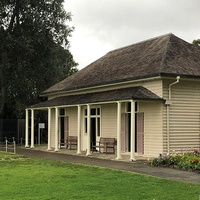
1. 1834, 1934 - Waitangi Treaty House
Tau Henare Drive, Waitangi
John Verge, William Gummer and William Page
Built for the family of James Busby, the first official sent by the British, the house was prefabricated in Sydney to a design by John Verge, New South Wales’ leading architect of the 1830s. Extended and altered over the years, following the Bledisloes’ gift of the Waitangi Estate in the 1930s, and in preparation for the centenary, the house was restored by William Page and William Gummer of Gummer & Ford — New Zealand’s pre-eminent firm of the time. More recent conservation work removed some of the accretions, and a visit gives insight into both the building’s history and our evolving understanding of heritage conservation.
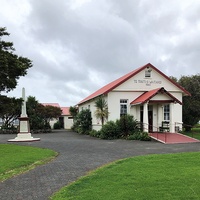
2. 1881 - Waitangi Memorial, Te Tii Marae
25 Te Karuwha Parade, Paihia
Buchanan Stonemasons
Te Tii Marae now plays a key part in annual celebrations, visited by dignitaries and politicians on the day before Waitangi Day, but, in 1840, it was the spot where the rangatira gathered on 5 February to discuss the Treaty before signing the following day. In the 1870s, Ngāpuhi gathered at Waitangi to discuss the Treaty and its subsequent dishonouring, deciding to petition their Treaty partner, Queen Victoria, directly. Following the return of their unsuccessful delegation, a wharenui and this memorial was erected at Te Tii, bearing the articles of the Treaty — the Maori version — carved in stone.
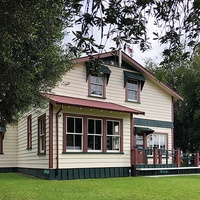
3. 1920 - Williams House (now Paihia Library)
2 Williams Road, Paihia
Unknown
The Williams family was among the earliest missionaries to New Zealand, Henry and his brother William establishing an Anglican Mission Station in Paihia in the 1820s. The family remained connected to the property for over 150 years, this house having been built on the site by Rev. Percy Williams (grandson of Henry), overlooking what is now the Village Green domain. The house was occupied by Percy’s daughter Mary for 43 years and, eventually, passed into public hands and was converted into a public library in 2003. Charmingly, bookshelves were inserted directly into the well-preserved interior, so the house still exudes period character.
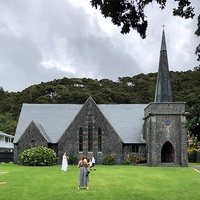
4. 1926 - Williams Memorial Anglican Church of St Paul
36 Marsden Drive, Paihia
Jones and Palmer
Gerald Jones was an Auckland architect best known for Arts and Crafts houses. Arthur Palmer was the son of Rev. John Palmer, one of the founders of the Melanesian Mission on Norfolk Island, and so had deep connections to the early church in New Zealand. At a meeting of Williams’ descendants marking the centenary of the family’s arrival, they voted to erect a stone church in memory of the work of Henry and William Williams. Both were (in many ways) key advocates for Māori and the grounds also include a memorial donated by North Island Maori following Henry’s death.
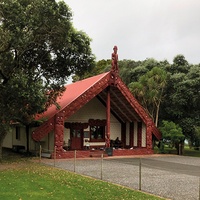
5. 1940 - Te Whare Runanga
Tau Henare Drive, Waitangi
School of Maori Arts and Crafts
The idea of a whare whakairo at Waitangi had been much discussed by Ngāpuhi but was eventually built to commemorate the centenary of the Treaty signing. It was positioned looking across to the newly restored Treaty House, the two buildings symbolising ‘ongoing conversation’. The design was driven by Sir Āpirana Ngata (Ngāti Porou) and the School of Māori Arts and Crafts in Rotorua but drew in a large crew of contributors. Key elements were produced locally under the guidance of master carver Pine Taiapa (Ngāti Hine). The interior carvings employ styles from several iwi, and represent tūpuna, both local and from further afield.
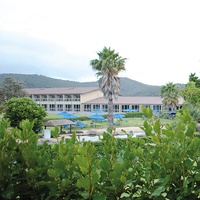
6. 1963, 1992 - Waitangi Hotel (now Copthorne Hotel)
Tau Henare Drive, Waitangi
William Pearson; Irwin Woolcott
The Tourist Hotel Corporation (THC) was established by the Government in 1955 and developed resort-style properties around the country, which were instrumental in raising the bar for hospitality in New Zealand. Like many of those, of which Hall & Mackenzie’s The Hermitage at Mount Cook (1958) might be the best preserved, this project employed a crisp, light style of modernism. The building has been expanded over the years but the 1960s’ core is discernible and it’s a great base from which to explore the area. William Pearson, the THC’s in-house architect, is the father of award-winning architect Rick Pearson.
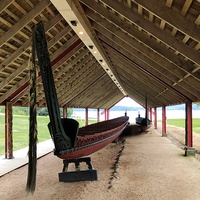
7. 1976 - Te Korowai ō Maikuku
Tau Henare Drive, Waitangi
Turbott & Associates
Known as the whare waka, this long shed houses Ngātokimatawhaora, the huge waka completed (like Te Whare Runanga) to celebrate the centenary of the Treaty signing. A railway down to the waterfront facilitates launching of the waka. Harry Turbott studied architecture at the University of Auckland and landscape at Harvard University, returning to become a pioneer in the field of landscape architecture in New Zealand. Amenities in national parks were a big part of Turbott’s oeuvre, and he produced a landscape plan for the Treaty Grounds, including the whare waka and an elevated boardwalk that links key elements of the site.

8. 1983, 2016 - Waitangi National Trust Visitor Centre
Tau Henare Drive, Waitangi
John Scott, Architect; Harris Butt Architecture
John Scott designed a limited number of civic buildings, of which this was the last. It has all the Scott hallmarks — concrete block walls, timber poles, brick floor tiles and timber linings — the sculpted roof lines defining a dramatic verandah and reception space. Following a path through a series of spaces, visitors were projected out into the trees on an elevated walkway and steps. Originally, the building was more exposed but the bush has closed in around it and it was altered in 2016. Much of the original fabric is still extant but the journey of the interior has been rather cleared out to create a gift shop

9. 1986 - Pioneer Apartments
44 Marsden Road, Paihia
Swan Railley & Associates
Swan Railley & Associates was an iteration of the long-running firm first established by David Swan and Robert Railley in the 1960s. Best known during its early days for sleek residential and tourism projects, the firm completed a number of projects around the Bay of Islands over the years. Still in great shape, this apartment block picked up the architectural language of self-assured international leisure during the 1980s’ economic boom — it overlooks the beach but might be equally at home on the slopes of Aspen — with bold angular forms, shingled walls and timber cladding. Bookable at pioneerapartments.co.nz. Hot tub party, anyone?

10. 1997 - Whare Waka Café
Tau Henare Drive, Waitangi
Turbott & Associates
Harry Turbott’s practice spanned building design, landscape architecture, urban planning and teaching the rapidly-expanding landscape discipline at the Department of Town Planning at the University of Auckland. Following on from earlier projects at Waitangi, he produced a café. Unsurprisingly, given Turbott’s landscape sensitivities, it has a great setting, nestled into the perimeter of a patch of bush and hovering over the edge of an existing pond. A wide, low verandah with a zigzagging rear wall creates pockets of sheltered space in which to sit and look out over the whare waka, the beach and the inlet beyond.

11. 2009 - Waitangi Gateway Building
Tau Henare Drive, Waitangi
Harris Butt Architecture
John Scott’s building had been altered and extended over the years, and the trees closed in around it such that there was no major architectural presence at the main point of arrival at the Treaty Grounds. This project draws the architectural welcome out to the car park and drop-off area. Riffing on aspects of John Scott’s building, the project employs a high, gable-end verandah, creating a light, bright space, which contrasts dramatically with the low, covered walkways through dense bush that take visitors further into the site. Harris Butt also completed the stylish Waitangi Toilet Block next door in 2009.
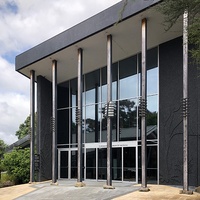
12. 2016 - Te Kongahu Museum of Waitangi and Education Centre
Tau Henare Drive, Waitangi
Harris Butt Architecture
After passing through the Gateway Building, visitors arrive at an atea space and a set of intricate contemporary pou — designed, with other key contributions, by artist Carin Wilson. Aside from this entry, the building’s simple black mass is intended to recede into the sloping hillside and the bush so that the project is primarily experienced as an interior. The focus there is on a choreographed series of fascinating displays — the exhibition design is by Workshop e — focusing on events at Waitangi and the period of early contact. Refer Architecture NZ May/June 2016.

13. 2020 - Te Rau Aroha Museum
Tau Henare Drive, Waitangi
Harris Butt Architecture
Bestowing an NZIA Auckland Architecture Award in 2021, the jury wrote that the building “tells the story of the 3600 men who served in the 28th Battalion, also known as the Māori Battalion, during the Second World War. These men are honoured in the building’s pensive mass, which evokes the beliefs that took these men so far away from home without promise of return. A monolithic form protects these stories while, inside, they are commemorated through darkness and light. …The building protects the memories of these men, so we can all remember them with mana and aroha.”
WORTH THE DRIVE
Kerikeri Mission House (1821)
218 Kerikeri Road, Kerikeri
Rev. John Butler
Te Waimate Mission House (1832)
344 Te Ahu Ahu Road, Waimate North
George Clarke
Stone Store (1836)
248 Kerikeri Road, Kerikeri
George Clarke
Christ Church (1836, 1871)
1–3 Church Street, Russell
Gilbert Mair; Sampson Kempthorne
Pompallier Mission and Printery (1842, 1993)
5 The Strand, Russell
Louis Perret; Salmond Architects
Ruapekapeka Pa (1845)
Timperley Road, Tōwai
Te Ruki Kawiti (Ngāti Hine)
Clendon Cottage (1847)
5 The Strand Russell
James Clendon
Former Customhouse (1870)
37 The Strand, Russell
William Clayton, Colonial Architect
Kawakawa Public Toilets (1999)
62 Gillies Street, Kawakawa
Friedensreich Hundertwasser
SOURCES
For all the significance of Waitangi in our national history, it hasn’t made a huge impact on our architectural literature. There’s a section on Waitangi in Frances Porter (ed.) Historic Buildings of New Zealand: North Island (Auckland: Cassell, 1979). The Treaty House is covered in both John Stacpoole’s Colonial Architecture in New Zealand (Wellington: A H & A W Reed, 1976) and Peter Shaw’s New Zealand Architecture (Auckland: Hodder & Stoughton, 1991). Deidre Brown’s Māori Architecture (Auckland: Raupo, 2009) doesn’t address Te Whare Rūnanga directly but outlines the development and work of the Maori School of Arts and Crafts. Likewise, David Straight’s John Scott Works (Auckland: Massey University Press, 2019) doesn’t cover his Waitangi building in any detail but is useful for putting the project in context — it’s more like his houses than his institutional work. Garth Falconer’s Harry Turbott: New Zealand’s First Landscape Architect (Wanaka: Blue Acres Publishing, 2020) has a useful section on Waitangi.

The itinerary series is supported by Dulux Colours of New Zealand. Dulux Colour Specialist Davina Harper has selected a Colours of New Zealand palette based on this itinerary. See the full range and order colour samples here.

